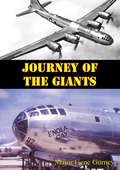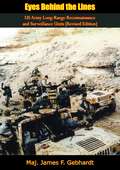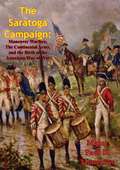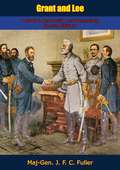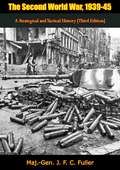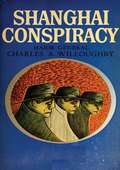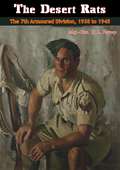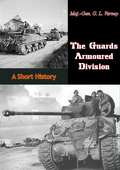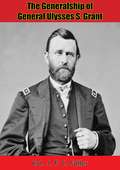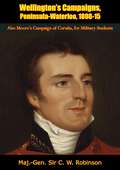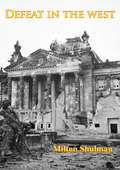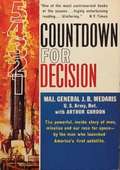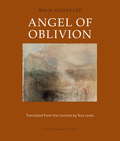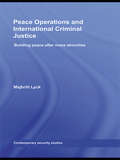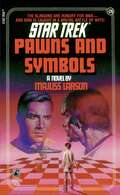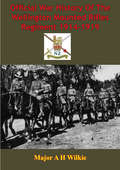- Table View
- List View
Journey of the Giants
by Maj. Gene GurneyThe story of the B-29 Superfort—the weapon that won the war in the Pacific.Major Gurney writes about B-29 operations in the Pacific, asserting that this aircraft was instrumental in forcing the Japanese to surrender.Much has been written about this great airplane, because any account of the devastating fire raids on Japan or of the dramatic beginnings of atomic warfare would be incomplete without telling the story of the B-29s which figured so prominently in these missions. But there is also an exciting story behind that story—the story of the giant bomber’s journey from the drawing boards of its designers to the day when out of the bomb bay of the “Enola Gay” tumbled the fantastic new weapon that, with a blinding flash and unprecedented power, brought about the dawn of the nuclear age. That is the story which Gene Gurney tells in Journey of the Giants, and he tells it well.The book ends with the historic scene on the battleship Missouri which signified the end of the war in the Pacific and, with it, the end of World War II. But while this was the climax in the B-29’s long journey, it was by no means its end. B-29s continued to serve a variety of important peacetime missions; they did their share in the development and testing of advanced nuclear weapons and, in the Korean War, added new battle honors to those gained in the Pacific.—Thomas S. Power, General, USAF, Commander in Chief, Strategic Air Command
Gold Swindle: The Story of Our Dwindling Gold
by Maj. George Racey JordanFirst published in 1959, this book by U.S. Army Air Corps Major George Racey Jordan tells of the loss of U.S. gold reserves under Franklin D. Roosevelt’s administration, when, in an effort to counter the deflation which was paralyzing the economy, Executive Order 6102 declared that all privately held gold of American citizens was to be sold to the U.S. Treasury and the price raised from $20 to $35 per ounce.In Gold Swindle: The Story of Our Dwindling Gold, Major Jordan discusses in detail the gold threat to national security, analyses the government’s power and sources thereof; describes the impending national crisis; and suggests steps to regain the U.S. citizens’ right to own and hold gold.
Eyes Behind the Lines: US Army Long-Range Reconnaissance and Surveillance Units [Revised Edition]
by Maj. James F. GebhardtEyes Behind the Lines: US Army Long-Range Reconnaissance and Surveillance Units is the 10th study in the Combat Studies Institute (CSI) Global War on Terrorism (GWOT) Occasional Paper series. This work is an outgrowth of concerns identified by the authors of On Point: The United States Army in Operation IRAQI FREEDOM. Specifically, these authors called into question the use of long-range surveillance (LRS) assets by commanders during that campaign and suggested an assessment ought to be made about their continuing utility and means of employment. This revision contains some important additional information the author received after this book was originally published.Major (Retired) James Gebhardt, of CSI, researched and wrote this Occasional Paper with that end in view. In this study, Gebhardt surveys the US Army s historical experience with LRRP and LRS units from the 1960s Cold War and Vietnam War, through their resurgence in the 1980s and use in Operations JUST CAUSE and DESERT STORM, to the advent of the GWOT. The paper's analytical framework examines each era of LRS units in terms of doctrine, organization, training, materiel, leadership, and personnel. In doing so, the author makes a strong case for continuing the LRS capability in the Army s force structure.The variety of environments and enemies likely to be faced by the military in the GWOT continues to demand the unique human intelligence abilities of trained and organized LRS units. As the Army leads the Armed Forces of the United States in combating terrorists where they live, the lessons found in this survey remain timely and relevant.
The Saratoga Campaign: Maneuver Warfare, the Continental Army, and the Birth of the American Way of War
by Maj. Paul D. MontanusThe Saratoga Campaign (June-October 1777) was a watershed event for the United States. The American conduct of the campaign is a textbook study in the application of the tenets of maneuver warfare principles at the operational and tactical levels. General Schuyler's brilliant shaping campaign against the British Forces as they advanced from Fort Ticonderoga to Albany forced General Burgoyne to detach elements of his force, which the Americans were able to isolate, mass forces against, and destroy. Ultimately, Schuyler's shaping cased the British campaign to culminate prior to the main engagements, known as the first and second battles of Saratoga. Occupying a prepared Defensive Position North of Saratoga, the Americans, led by General Arnold, conducted a forward oriented Defense that seized the initiative from the British and disrupted their preconceived plans. The American counter-attacks which demonstrated the American Mastery of seeking gaps and avoiding surfaces, attrited the British Force to such an extent that they were forced to surrender. The victory of the makeshift American Force over the Professional British-Led Force demonstrates the superiority of maneuver warfare versus Attritionist Techniques, and is of contemporary interest to the USMC.Richly illustrated throughout.
Grant and Lee: A Study in Personality and Generalship [Second Edition]
by Maj.-Gen J. F. C. FullerFirst published in 1957, this second edition of the analysis of the generalship of Ulysses S. Grant and Robert E. Lee remains one of the most readable histories of the Civil War. The author began his research sharing the generally held assumption that Lee was a great general and Grant a clumsy “butcher.” By the time Fuller completed his project, however, he regarded Grant as the greatest general of his age and one of the greatest strategists of any age. Grant and Lee is a compelling study not only of two remarkable men but also of the nature of leadership and command in wartime.“...cuts squarely across the accepted tradition...[Fuller] examines these two great soldiers from a fresh viewpoint and refuses to let himself be bound by tradition.”—Bruce Catton, New York Times Book Review“...a stimulating study which appreciates both the unique personalities of the protagonists and the social conditions which stamped their tactics.”—Commonweal“Fuller’s...analysis and comparison of the personality, leadership, and generalship of Grant and Lee is as readable, instructive, stimulating, and...controversial as when first published.”—Military Review
The Conduct of War, 1789-1961: A Study of the Impact of the French, Industrial, and Russian Revolutions on War and its Conduct
by Maj.-Gen J. F. C. Fuller“A tour de force in the way it embraces and weaves together the political, economic and military factors”—B. H. Liddell Hart“A work which sums up succinctly the learning of a life-time.”—New StatesmanThe Conduct of War, 1789-1961, which was originally published in 1961, is a study of the way in which political and economic changes since the French Revolution have altered both the techniques and the aims of war.The author begins by studying the limited wars that were possible in the age of absolute rulers, and the destructive impact of revolutionary and democratic government on this state of affairs. Not only did the new armies of the Napoleonic age grow immensely in size and military power: the aims for which the war was fought began to change.Now it is no longer a question of forcing the enemy government to change its policy in specific ways: the purpose is the destruction of that government and the absolute surrender of its people.Such a concept of war, the author contends, is a disastrous return to barbarism, and in this book he considers his study in the light of post-war events with Communist countries.
The Second World War, 1939-45: A Strategical and Tactical History [Third Edition]
by Maj.-Gen J. F. C. FullerBritish General J. F. C. Fuller is one of the greatest military thinkers of this century, and has been called the Clausewitz of our time. This book is Fuller’s direct and clear-eyed account of the most terrible war of the modern era. When first published in 1948, it received notices such as these:“The strategic and tactical phases of the war are brilliantly expounded...on that score, the book stands as probably the best comprehensive work on the war to appear so far.”—The New Yorker“The narrative, valuable as it is, is not the most important part of General Fuller’s book. What really matters is the author’s comments on the events he describes, and these provide us with a clear statement of what he thinks not only about particular operations but about the conduct of the war as a whole. The result is a hard-hitting politico-military pamphlet, in which none of the punches are pulled.”—The Spectator“[Fuller] knows how to handle a narrative full of incident; he is thoroughly at home in a subject in which he has kept himself up to date; and...he is one of the very rare original students of warfare whom this country has produced.”—Times Literary SupplementFuller’s biographer, Bryan Holden Reid, has described The Second World War as “an analysis of the breakdown, as Fuller saw it, of the vital relationship between grand strategy and grand tactics—the end and the means....Too often books on the Second World War detail the movements of formations about the battlefield and give space to strategical commentary without assessing the manner in which the war was actually fought. On the tactical level, The Second World War can still be read with profit.”Expertly combining detailed military history and analysis with Clausewitzian insights based on his own theories of warfare, Fuller produced a modern military masterpiece in The Second World War.
Railroading in Eighteen Countries: The Story of American Railroad Men Serving in the Military Railway Service, 1862 to 1953
by Maj.-Gen. Carl R. GrayThis is the story of the Military Railway Service of the United States Army from its beginning in 1862 and including a brief account of the Service in World War I. It is specifically the story of the military use of railroads in World War II and in Korea. General Gray has focused his comprehensive account on the performance of the personnel of the Service, and on outstanding individuals wherever possible. Out of more than 351,000 men and women employees of American railroads serving in all arms in World War II, 43,500 were assigned to various units of the Military Railway Service. This impressive record of their achievements covers history, organization, training and operations in Alaska, England, North Africa, Sicily and Italy, Northern France and Belgium, Southern France, Germany and Austria, Iran, India, the Philippines, New Caledonia, Australia, Japan and Korea.A notable feature of this handsome volume is the wealth of fine photographs of operations in all areas, for the most part photographs not seen before.
Shanghai Conspiracy: The Sorge Spy Ring, Moscow, Shanghai, Tokyo, San Francisco, New York
by Maj.-Gen. Charles A. WilloughbyOriginally published in 1952, General Willoughby's book Shanghai Conspiracy, which includes the story of Richard Sorge, is of the gravest importance because it presents a clear delineation of a worldwide pattern of Communist sabotage and betrayal which was still being practiced at the time of publication in 1952.During [the U.S.'s] Occupation of Japan, military intelligence exercised limited civil functions in collaboration with the modernized Japanese police, in an alert against national and foreign communism. The story of Richard Sorge, Soviet master spy, falls into this category of security surveillance. It represents a devastating example of a brilliant success of espionage--its evolution, techniques, and methods. Elements of this Soviet-inspired conspiracy actually ranged from China and Japan into the United States, in the period 1931-50.Over a period of years, there has been filed with Washington a most extensive documentation on the case, aggregating over a million words with hundreds of plates, photostats, and illustrations. Enormous efforts in translation and research have gone into it. It has been reviewed and authenticated by American lawyers, and is now being brought into focus by the Senate and House Committees on Internal Security and Un-American Activities.Sorge's story did not begin or end with Tokyo but was only a chip in the general mosaic of Soviet Far Eastern strategy. It deals with a sinister epoch in the history of modern China and must be viewed against the vicious background of world conspiracy. Shanghai was a vineyard of communism for men and women of many nationalities who had no conceivable personal stake in China, but an almost inexplicable fanaticism for an alien cause--the Communist subjugation of the Western world. Here were sown the dragon's teeth that have since ripened into the Red harvest of today.
The Desert Rats: The 7th Armoured Division, 1938 to 1945
by Maj.-Gen. G. L. VerneyThe exploits of the Desert Rats, based on official records and personal accounts traces the division’s progress in North Africa, Italy, Normandy and GermanyThis classic and inspiring account follows the progress of the 7th Armoured Division from the sands of North Africa to the cold of wintery Holland and the mud of a German springtime, providing a unique insight into the workings of a formidable unit.The division’s reputation was born in the desert. It first went into action against the Italians in 1940 and then, subsequently, fought Rommel’s Afrika Korps in Montgomery’s successful Western Desert campaign.It was during this period of intense fighting that the division won its affectionate nickname of ‘Desert Rats’.From there the division was transported to Italy and, later, Normandy and from then on was almost constantly in battle until the end of the war.Based on official records, and written by one of the division’s key officers, The Desert Rats stands testament to the unique morale of the unit and is an enduring story of the difficulties they had to overcome.
The Guards Armoured Division: A Short History
by Maj.-Gen. G. L. VerneyFirst published in 1955, this book is a short history of the Guards Armoured Division, which was an armoured division of the British Army during the Second World War.The division was created in the United Kingdom on 17 June 1941 during World War II from elements of the Guards units, the Grenadier Guards, Coldstream Guards, Scots Guards, Irish Guards. and Welsh Guards.The division remained in the United Kingdom, training, until 13 June 1944, when it landed several armoured command vehicles at Arromanches and lagered its advanced tactical headquarters in communication with GHQ awaiting the bulk of the armour Normandy, France, during Operation Overlord as part of VIII Corps, where its first major engagement was Operation Goodwood, the attack by three armoured divisions towards Bourguebus Ridge in an attempt to break out of the Normandy beachhead.The division existed until 12 June 1945, more than two months after Victory in Europe Day, when it was reorganised as an infantry division, the Guards Division, after almost exactly four years as an armoured division.
A.E.F., Ten Years Ago in France
by Maj.-Gen. Hunter LiggettA fascinating series of accounts from Major-General Hunter Liggett who commanded 41st Division, then 1st Army Corps, A.E.F. before the entire 1st American Army. A significant and underappreciated leader of the United States war effort during the First World War and a prominent member of the U.S. army command for over four decades.“Lieutenant General Hunter Liggett (March 21, 1857 − December 30, 1935) was a senior United States Army officer. His 42 years of military service spanned the period from the Indian campaigns to the trench warfare of World War I. Additionally, he also identified possible invasion sites in Luzon, particularly Lingayen Gulf, which were used during World War II in 1941 by the Japanese and in 1945 by the United States.Success in brigade commands in Texas and in the Philippines led to his promotion to major general, and selection as commander of the 41st Division in April 1917. The division served in France as part of the American Expeditionary Force. When his division was disestablished, he took command of I Corps.Under Liggett's leadership, the I Corps participated in the Second Battle of the Marne and in the reduction of the Saint-Mihiel salient. In October 1918, as commander of the First United States Army with the rank of lieutenant general in the national army, he directed the final phases of the Meuse-Argonne offensive and the pursuit of German forces until the armistice. After commanding the post-war Army of Occupation, Liggett returned to his permanent rank of major general, and retired in 1921.Throughout most of this period, Liggett's aide-de-camp was James Garesche Ord, a major general in World War II.”-Wiki
The Generalship of General Ulysses S. Grant
by Maj.-Gen. J. F. C. Fuller“THE greatest event in European history was the discovery of the New World: today it could only be rivalled by landing on a habitable planet. The greatest event in American history was the Civil War; greater than the Rebellion, because separation from England was sooner or later inevitable. The man who most greatly influenced this war was Ulysses S. Grant; not because he was so clear-sighted a statesman as Lincoln, or so clever a tactician as Lee, but because he was the greatest strategist of his age, of the war, and, consequently, its greatest general.Grant was not of the type of Alexander, Cæsar, Frederick and Napoleon: he was a simple-minded man of vision, and one who for nearly forty years remained an obscure citizen of the Great Republic. It is for this reason that I have dedicated my book on his generalship to the Youth of America; for I believe that the second greatest event in American history was the recent World War, which, cracking the Old World to its foundations, left the United States standing like a granite rock.In writing this book my object has been to examine what Grant accomplished as a soldier; to show that as such he has not been fully appreciated, and that as he looked upon war as a necessary evil so long as peace remains imperfect, we also, after the greatest war in modern times, may find in his honesty and in his vision our direction towards creating a happier and less turbulent world. “Let us have peace,” he said: well then—let us examine war.”—J. F. C. Fuller, Preface
A Year's Campaigning in India, from March, 1857 to March, 1858
by Maj.-Gen. Julius George MedleyIn A Year’s Campaigning in India, which was first published in 1858, author Julius George Medley provides the reader with a vivid account of the events—and the distinguished part he took—in March 1857 through to March 1858 during the India Rebellion.The rebellion began on 10 May 1857 in the form of a mutiny of sepoys of the Company's army in the garrison town of Meerut, 40 miles northeast of Delhi (now Old Delhi). It then erupted into other mutinies and civilian rebellions chiefly in the upper Gangetic plain and central India, though incidents of revolt also occurred farther north and east. The rebellion posed a considerable threat to British power in that region, and was contained only with the rebels' defeat in Gwalior on 20 June 1858.Medley’s narrative focuses on the Bozdar Expedition in the Derajat Hills, in March 1857; the Siege and Capture of Delhi, in September 1857; Colonel Seaton’s Campaign in the Doab, in December, 1857; and the Siege and Capture of Lucknow, in March 1858.An unmissable addition to complete any British Military History collection.
Wellington's Campaigns, Peninsula-Waterloo, 1808-15: Also Moore's Campaign of Coruña, for Military Students
by Maj.-Gen. Sir C. W. RobinsonIn this book, first published in 1907, all three parts of Wellington’s Campaigns, hitherto published separately, are brought out together in one volume.The consolidated volume covers all campaigns fought during the Peninsula War in Portugal, Spain, and the South of France between 1808 and 1814 and concludes with the Waterloo campaign in 1815. It also contains an additional Appendix concerning the influence of certain Spanish operations and special circumstances in Spain upon the movements of Moore and Wellington.Richly illustrated throughout with sketch maps and plans.
Henry Clifford V.C.: His Letters and Sketches from the Crimea
by Maj.-Gen. Sir Henry Hugh Clifford V.C.First published in 1956, this book is a rich collection of letters written by Major-General Sir Henry Clifford during his service in the Crimean War, where he received the appointment of aide-de-camp to Sir George Brown, commanding the light division, and was present at Alma and Inkerman. For his gallantry in the latter battle, Clifford was decorated with the Victoria Cross, in honour of leading one of the charges, killing one of the enemy with his sword, disabling another, and saving the life of a soldier."In reading these letters one cannot fail to be impressed by the noble character of the writer: a man of great courage, both moral and physical, a fine leader of men, and a first-rate officer, quick in his grasp of a difficult situation, forthright in his opinions and criticisms. Even by our standards of today he would certainly be classed as well above the average of his rank. [...]It is a great privilege to read these frank and vivid letters of 100 years ago and to learn from them at first hand of the courage and endurance of the British soldier in adversity."Richly illustrated throughout with Clifford's own sketches and notes, plus three maps.
Defeat in the West (Sven Hassel War Classics)
by Milton Shulman Maj.-Gen. Sir Ian JacobTHE STORY OF THE COLLAPSE OF THE GERMAN ARMIES IN THE WEST AND A STUDY OF THE HISTORY OF WORLD WAR II, AS TOLD FROM THE GERMAN POINT OF VIEWIn 1945, the once mighty Wehrmacht was reduced to a pathetic shadow of its former self as the thousand-year Reich lay in ruins. The war in the West had been lost and its protagonists scattered in prisoner of war camps across Europe.Author Milton Shulman joined the Canadian Army HQ three months before D-Day as a major and was promoted to intelligence officer by war's end. As part of his duties, he made close personal contact with the German Army throughout intelligence operations in France, Belgium, Holland and Germany. While still in uniform, he also interviewed many of the captured German generals in the following months and years, including Gerd von Rundstedt, ‘Sepp’ Dietrich and Kurt Meyer—26 in all. From them, Major Shulman learnt why it was that such a superbly armed body of fighting men suffered such a calamitous defeat.This absorbing book is the result of those interviews. First published in 1947, it was the first account to reveal the truth of what happened in the war: how Hitler and his General Staff planned their campaigns, how the discipline and ignorance of the German military machine served Hitler well and Germany badly—and why victory finally slipped from their hands.“The best and most vivid account of the German collapse”—Hugh Trevor Roper, The Sunday Times
Countdown For Decision
by Maj.-General J. B. MedarisThe inside story of men, missiles and our race for space by the man who launched America's first satellite.John Bruce Medaris (May 12, 1902 - July 11, 1990) retired a Major General in the United States Army. During World War II he became a highly decorated colonel in the ordnance corps, serving in every campaign from North Africa to Sicily, Normandy, the Battle of the Bulge, and invasion of Germany. In 1955 he assumed command of the Army Ballistic Missile Agency. Under his supervision Wernher von Braun and the Rocket Team developed the Jupiter missile which launched the first U.S. earth satellite into orbit in 1958. Medaris went on to play a role in the post-Sputnik debates over how the U.S. government ought to respond to the Soviet challenge. When the Eisenhower administration decided to create a civilian space agency, assigned long-range ballistic missiles to the Air Force and Navy, then transferred the Huntsville Rocket Team to the NASA. Derived from a Kirkus review: The Army's recently retired top missile-and-ballistics man, Major General Medaris, tells the story of the missiles race of the last five years, and makes some predictions about the future. Beginning with a brief personal history, coinciding with the development of rocketry through Dr. Robert Goddard and Werner von Braun, he then goes into specific detail of the years 1956-59, during which time he ran the rockets from the Redstone Arsenal and Cape Canaveral. Some of the heroes are men like Colonel Nickerson; Secretary McElroy; and von Braun. Other heroes are the missiles themselves—Nike, Bomarc, Jupiter, Titan, and a dozen more—whose history and sometimes frustrating failure Medaris recounts. The General sounds the alarm against complacency, and against bureaucracy. Unless, he says, men of decision and intelligence are allowed to carry out a balanced, imaginative rocket program, the power will soon shift decidedly to Russia. Well worth reading.-Print ed.
Angel of Oblivion
by Maja Haderlap Tess LewisHaderlap is an accomplished poet, and that lyricism leaves clear traces on this ravishing debut, which won the prestigious Bachmann Prize in 2011. The descriptions are sensual, and the unusual similes and metaphors occasionally change perspective unexpectedly. Angel of Oblivion deals with harrowing subjects - murder, torture, persecution and discrimination of an ethnic minority - in intricate and lyrical prose.The novel tells the story of a family from the Slovenian minority in Austria. The first-person narrator starts off with her childhood memories of rural life, in a community anchored in the past. Yet behind this rural idyll, an unresolved conflict is smouldering. At first, the child wonders about the border to Yugoslavia, which runs not far away from her home. Then gradually the stories that the adults tell at every opportunity start to make sense. All the locals are scarred by the war. Her grandfather, we find out, was a partisan fighting the Nazis from forest hideouts. Her grandmother was arrested and survived Ravensbrück.As the narrator grows older, she finds out more. Through conversations at family gatherings and long nights talking to her grandmother, she learns that her father was arrested by the Austrian police and tortured - at the age of ten - to extract information on the whereabouts of his father. Her grandmother lost her foster-daughter and many friends and relatives in Ravensbrück and only escaped the gas chamber by hiding inside the camp itself. The narrator begins to notice the frequent suicides and violent deaths in her home region, and she develops an eye for how the Slovenians are treated by the majority of German-speaking Austrians. As an adult, the narrator becomes politicised and openly criticises the way in which Austria deals with the war and its own Nazi past. In the closing section, she visits Ravensbrück and finds it strangely lifeless - realising that her personal memories of her grandmother are stronger.Illuminating an almost forgotten chapter of European history and the European present, the book deals with family dynamics scarred by war and torture - a dominant grandmother, a long-suffering mother, a violent father who loves his children but is impossible to live with. And interwoven with this is compelling reflection on storytelling: the narrator hoping to rid herself of the emotional burden of her past and to tell stories on behalf of those who cannot.From the Trade Paperback edition.
Peace Operations and International Criminal Justice: Building Peace after Mass Atrocities (Contemporary Security Studies)
by Majbritt LyckThis new volume provides the first thorough examination of the involvement of peace enforcement soldiers in the detention of indicted war criminals. The book firstly addresses why peace enforcement missions need to be involved in detaining indicted war criminals. This discussion includes an analysis of how the securing of justice and transitional j
Pawns and Symbols (Star Trek: The Original Series #26)
by Majliss LarsonA thrilling Star Trek: The Original Series adventure following Captain Kirk in race against time against the Klingon Empire.Threatened by a deadly famine, the Klingon Empire is on the verge of igniting a mad interplanetary war of conquest. When an earthquake destroys a remote Federation research station, Jean Czerny, agricultural scientist, succumbs to amnesia. Stranded on enemy borders, she is imprisoned by Kang, the evil commander of a Klingon battleship. Now Kirk must play a dangerous game of mind strategy to prevent a savage attack on the Federation!
Official War History Of The Wellington Mounted Rifles Regiment 1914-1919 [Illustrated Edition]
by Major A H WilkieIllustrated with over 40 photos and 10 maps"Official history of a NZ Regiment which saw service in the Middle East in the Great War.The Regiment was established in 1911, but this book deals solely with its WWI services - Egypt, Gallipoli and Palestine (Gaza, Beersheba, Jerusalem, Jordan). The narrative is clear and informative, with plenty of detail and with many individuals mentioned by name (especially casualties). Apps: Roll of Honour (KIA and WIA, Gallipoli and Palestine), H & A, List of COs.--N&M Print Version
Napoleon and Waterloo: The Emperor’s Campaign with the Armée Du Nord, 1815 [Revised Edition]
by Major A. F. BeckeThis is the 1936 revised edition of the 1914 two-volume account of Napoleon's last campaign by Britain's pre-eminent military historian of the early 20th century, now combined in one handy single volume.This first part takes the story of the Hundred Days from the Emperor s return from exile in Elba up to his despatch of the incompetent Marshal Grouchy to head off the Prussians while he faced Wellington at Waterloo. The book looks at Napoleon's strategy and tactics as well as his disposition of his Armée du Nord and the battles of Quatre Bras and Ligny.The second part looks at the climactic confrontation between Napoleon and Wellington at Waterloo itself and has a number of appendices relating to the great battle, including orders of battle of the French, British, Dutch and Prussian forces engaged and correspondence between Napoleon and Marshals Soult, Davout, Ney and Grouchy.Contains 11 maps (including 6 new maps).A must for anyone interested in the Napoleonic wars, and the single volume should make it easier for both the general reader and the student to follow the campaign in its entirety.
Nery, 1914: The Adventure of the German 4th Cavalry Division
by Major A. F. BeckeFascinating account of the apparently minor chance encounter between German and British cavalry, supported by artillery, in the opening stages of the First World War as the German army wheeled through Belgium and Northern France. The engagement was a tenacious struggle and L Battery of the Royal Horse Artillery won three VCs and the honour title "Nery" during this clash.Illustrated with 4 sketches and 4 photographs.
The Royal Regiment of Artillery at Le Cateau: Wednesday, 26th August, 1914
by Major A. F. BeckeThis book, first published in 1919, represents a study undertaken by former Royal Artillery Major Archibald Frank Becke on the action fought by General Sir H. Smith-Dorrien and the troops under his command on August 26th, 1914 at Le Cateau--a critical day that proved not only a triumph for the British arms, but had a most important bearing on the whole retreat.The book served to show Officers of the Regiment the use that will be made of their War Diaries, and the nature of the information that is required for historical work, and also to encourage all Officers who were present at the battle to submit any further information that was in their possession. Lastly, Becke intended the book to be of scholarly use.
